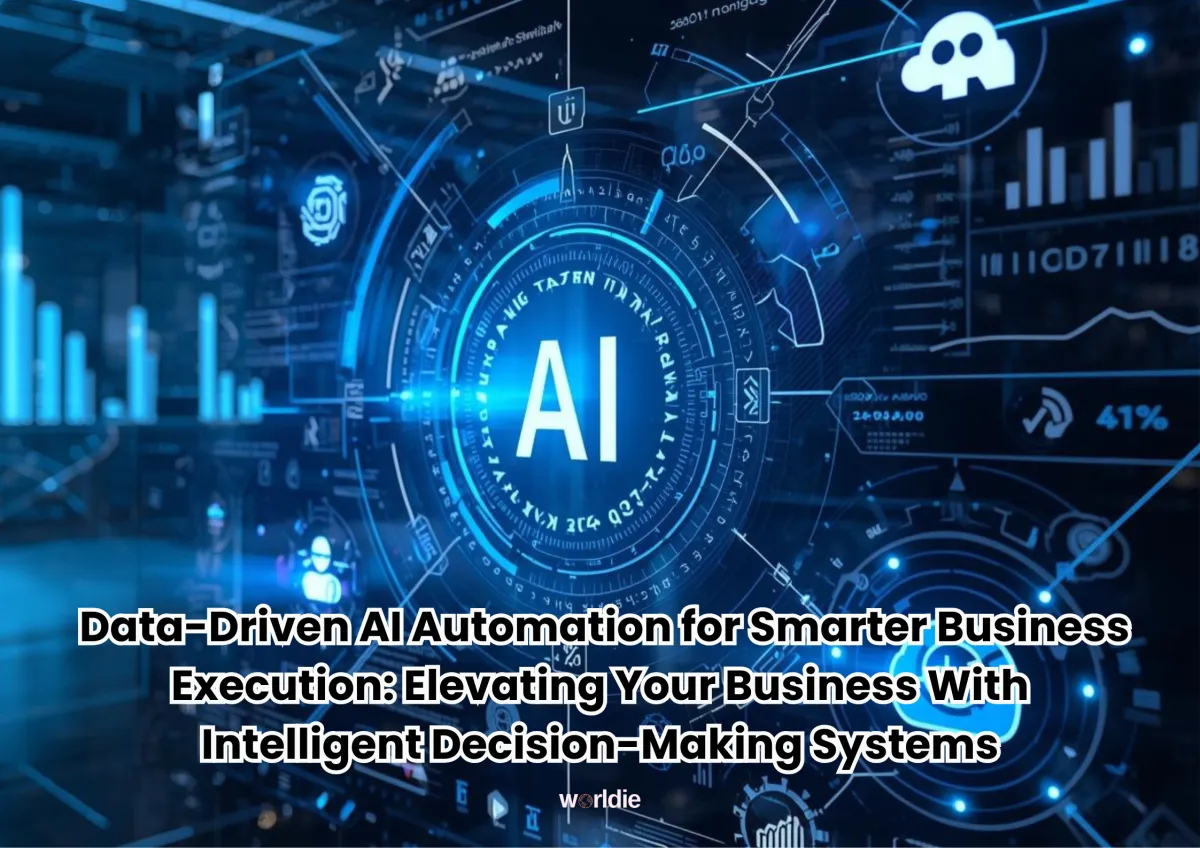
Data-Driven AI Automation for Smarter Business Execution: Elevating Your Business With Intelligent Decision-Making Systems
Data-driven AI automation for smarter business execution is rapidly becoming the backbone of organizations seeking higher efficiency, greater leverage, and measurable revenue expansion. As the volume of data outpaces human capacity to interpret it and workflows grow in complexity across digital ecosystems, leaders are realizing that growth requires more than hiring faster or pushing teams harder. It requires intelligence embedded directly into the operational fabric of the business.
Worldie AI specializes in building the systems that turn raw information into automated decisions, workflows, predictions, and actions. The goal is simple: create a business that executes with precision, learns from every interaction, and scales without friction. If you’ve been assessing whether your business is ready for AI-driven acceleration, this guide will give you the clarity and strategy you need.
What “Data-Driven AI Automation for Smarter Business Execution” Really Means
The phrase itself blends three powerful capabilities—data, AI, and automation—into a single operational engine. At its core, it refers to business systems that don’t wait for manual inputs, delayed decisions, or slow human processing. Instead, they use real-time data to trigger intelligent actions, optimize workflows, and guide teams toward outcomes aligned with growth goals.
Rather than relying on basic task automation, this discipline uses machine learning models, predictive analytics, LLMs, and integrated data pipelines to make operations fast, self-correcting, and far more strategic.
Many leaders think automation simply means reducing manual steps. In reality, when powered by data and AI, automation becomes a system that thinks, adapts, and continuously improves how work gets done.
Why Businesses Struggle with Execution in the First Place
Every business reaches a point where its internal processes slow growth more than its competitors or market constraints ever could. These issues often build quietly until they start affecting revenue, customer retention, and team performance.
Teams usually face the same battles:
1. Data Is Scattered Across Too Many Tools
Companies rely on CRMs, spreadsheets, messaging apps, project trackers, analytics platforms, and customer databases. None of these tools speak the same language, and without integrated intelligence, leaders can't make decisions fast.
2. Repetitive Tasks Consume High-Value Time
Manual reporting, customer updates, lead qualification, proposal drafting, handoffs, quality checks, and documentation drain the energy and attention needed for strategic work.
3. Decisions Come Slower Than Market Movements
When decisions rely on human interpretation alone, opportunities expire before teams even respond.
4. Operations Grow, but the Team Can’t Keep Up
Scaling revenue typically means scaling people—unless the company has an AI backbone that handles the execution layer.
5. No Continuous Learning Loop Exists
If outputs are not analyzed, stored, and used to improve future performance, the business repeats the same slow cycles.
This is where data-driven AI automation becomes an advantage that compounds over time.
How Data Turns Into Automated Intelligence
The transformation begins the moment data moves from being static information to becoming an active participant in operations.
When data is properly structured and connected, AI systems can:
Predict outcomes
Identify anomalies
Generate insights
Trigger workflows
Recommend next actions
Assign tasks
Draft content
Simulate scenarios
Respond to customers
Optimize resources
This allows the organization to operate with the clarity and speed of an autonomous system that always knows what to prioritize and how to execute it.
Where Data-Driven AI Automation Creates the Highest Lift
The applications span every industry, but the impact tends to be felt in similar patterns across sectors.
Revenue & Sales Operations
Predictive lead scoring, automated outreach, follow-up sequencing, deal forecasting, product recommendations, and AI-assisted proposals transform the sales cycle into a predictable, scalable engine.
Marketing Execution
Content generation, campaign optimization, audience segmentation, real-time analytics, and channel allocation become faster and far more targeted.
Customer Operations
Intelligent routing, AI-driven support, automated case resolution, knowledge base expansion, and customer journey orchestration reduce response times and improve satisfaction.
Product & Service Delivery
Automated quality checks, AI-powered documentation, workflow scheduling, anomaly detection, and operational forecasting reduce delays and eliminate costly errors.
Finance & Administration
Smart invoicing, expense classification, automated reporting, compliance checks, and budget simulations give leaders complete transparency into the financial health of the business.
People Operations
Automated onboarding, skills assessments, training suggestions, schedule coordination, and performance analysis help the team move with greater focus.
Every workflow that repeats, delays execution, or suffers from manual errors becomes an opportunity to embed intelligence—once the data foundation exists.
Why Data-Driven AI Beats Traditional Automation
Traditional automation follows rigid rules.
Data-driven AI automation evolves through patterns, outcomes, and continuous learning.
Traditional automation reacts.
Data-driven AI predicts, initiates, and adapts.
Traditional automation reduces workload.
Data-driven AI transforms business bandwidth.
This distinction is critical for leaders designing scalable systems. What once required large teams and long hours can now be handled by integrated models that digest information, deliver insights, and take action without slowing down.
This is the shift that turns AI from a “tool” into an operational brain.
The Worldie AI Approach: Design → Build → Release
Every AI system created by Worldie AI follows a clear engineering methodology built to support real business outcomes.
Design Phase
This phase identifies operational bottlenecks, data gaps, workflow inefficiencies, and growth opportunities. The goal is to craft an AI architecture that matches the organization’s strategic vision. During this stage, we outline data pipelines, model requirements, automation flows, integrations, and user experience layers.
Build Phase
Engineers build the AI models, automations, knowledge systems, training loops, and dashboards. This is where machine learning and LLMs are fine-tuned, data is cleaned and structured, and workflows are encoded into intelligent sequences.
Release Phase
The AI system is deployed into your live environment with safeguards, training, and iteration cycles. Feedback loops are connected, allowing the system to learn and improve with real-world usage.
This method ensures that the AI doesn’t simply automate tasks but elevates the organization’s entire execution capacity.
Challenges Companies Face When Deploying AI (and the Solutions)
AI deployment isn’t plug-and-play. Leaders often underestimate the groundwork required for systems to operate at peak performance.
The most common challenges include:
1. Data Quality Issues
Inaccurate, incomplete, or inconsistent data can distort predictions and reduce automation reliability. The fix involves structured data cleaning, centralized storage, and pipelines designed for ongoing validation.
2. Legacy Tools That Don’t Integrate
When old systems don’t communicate with new AI engines, data becomes trapped. API engineering and middleware layers solve most integration gaps.
3. Lack of Clear Operational Frameworks
AI performs best inside well-defined processes. Streamlining workflows before automation improves long-term performance.
4. Team Resistance or Skill Gaps
Training sessions, documentation, and hands-on adoption support help teams embrace AI as an ally instead of a threat.
5. Unrealistic Expectations
AI amplifies growth but relies on measured rollout and proper training. Worldie AI aligns each deployment with achievable outcomes and transparent benchmarks.
AI success is not about quick hacks; it’s the result of strong data foundations and strategic integration.
What Metrics Reveal High-Performing AI Execution
Leaders rely on metrics to gauge whether the AI is doing more than automating tasks. The best measures of success are tied to both performance and growth outcomes.
Key indicators include:
Cycle time reduction
Error rate decrease
Revenue per employee
Customer response speed
Forecast accuracy
Cost-per-output improvements
Team productivity lift
Repeatable workflow consistency
Companies that track these indicators quickly see where AI is amplifying execution and where to expand its capabilities.
Transformations Businesses Experience When Data-Driven AI Takes Over
When AI begins guiding execution, the shift is felt across every department.
Sales teams finally work with complete visibility.
Marketing runs with clarity and consistency.
Customer support moves with confidence.
Operations run with fewer interruptions.
Leaders make decisions backed by data rather than assumptions.
Workflows once slowed by human bottlenecks turn into fluid, self-operating systems. The organization builds momentum, teams spend more time on high-impact work, and leaders gain leverage that compounds quarter after quarter.
This is the type of transformation that reshapes how revenue is generated.
Why Data-Driven AI Automation Creates Revenue Impact
Smarter execution compounds revenue in multiple dimensions simultaneously:
Better qualified leads
Faster sales cycles
Higher output per employee
More accurate predictions
Healthier customer relationships
Stronger decision-making
Fewer operational delays
Lower cost per task
Instead of relying on human bandwidth, the company relies on systems engineered for consistency and growth. Worldie AI’s architectures are designed so the business doesn’t expand its workload along with its revenue—it expands its capability.
The Real Advantage: An Organization That Learns on Its Own
When your systems remember
When your processes adapt
When your workflows improve
When your insights sharpen
When your outcomes become predictable
You build an organization that learns faster than its competitors. This creates a long-term competitive edge that’s extremely difficult to replicate.
The businesses winning the next decade won’t be the ones with the biggest teams. They’ll be the ones with the smartest systems.
Worldie AI builds those systems from the ground up.
FAQ: Data-Driven AI Automation for Smarter Business Execution
1. How fast can a company start seeing value from data-driven AI automation?
Many organizations see early traction within the first few weeks once foundational data pipelines and automations are live. The deeper gains emerge as the system learns from continuous interactions and refines its outputs.
2. Does a company need massive amounts of data to implement AI automation?
Not always. High-quality, structured data is more valuable than sheer quantity. Even small and midsize companies can deploy AI systems effectively once their data sources are organized and connected.
3. How does AI automation affect existing teams and job roles?
AI removes repetitive execution work so teams can shift to strategic tasks. It supports employees rather than replacing them, giving them leverage to handle higher-value responsibilities.
4. Can AI be added on top of existing software and tools?
Yes. Most systems can be integrated through APIs, middleware, or custom connectors. The key is building an architecture that allows data to flow freely and securely.
5. What makes Worldie AI different from generic automation or AI tools?
Worldie AI builds fully customized AI infrastructures tailored to your workflows, data sources, and growth targets. Instead of using generic templates, each system is engineered to directly improve revenue, execution, and long-term scalability.

